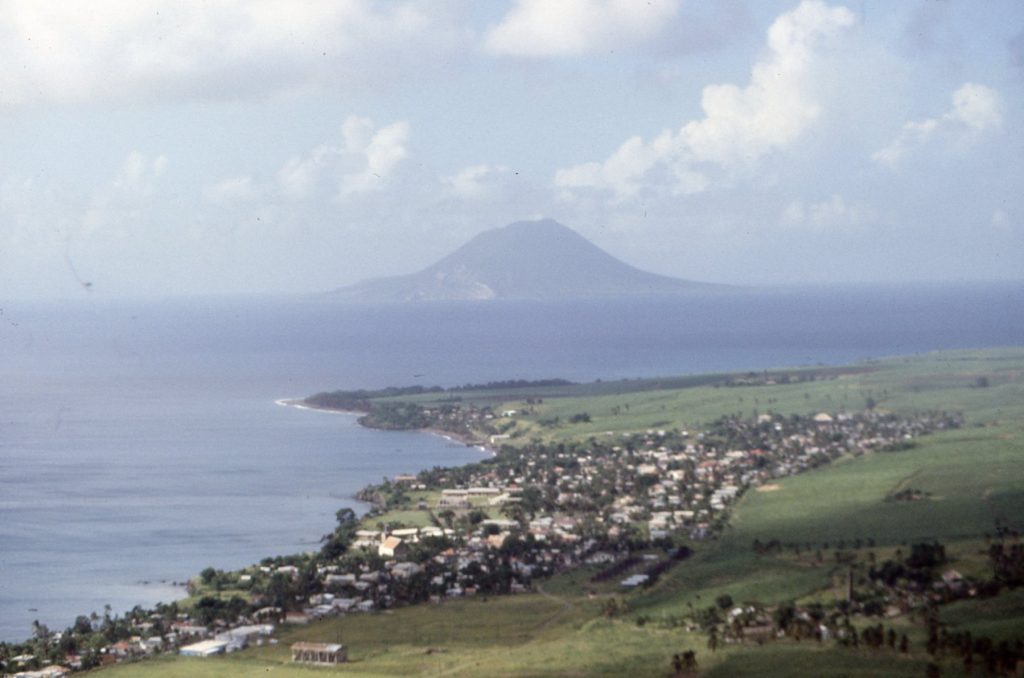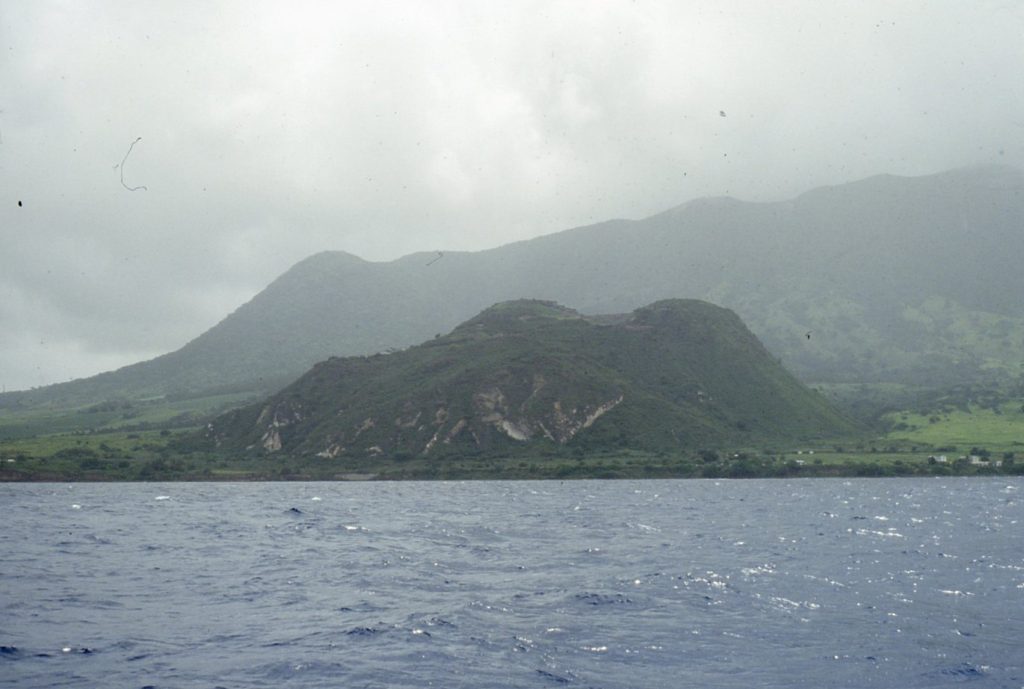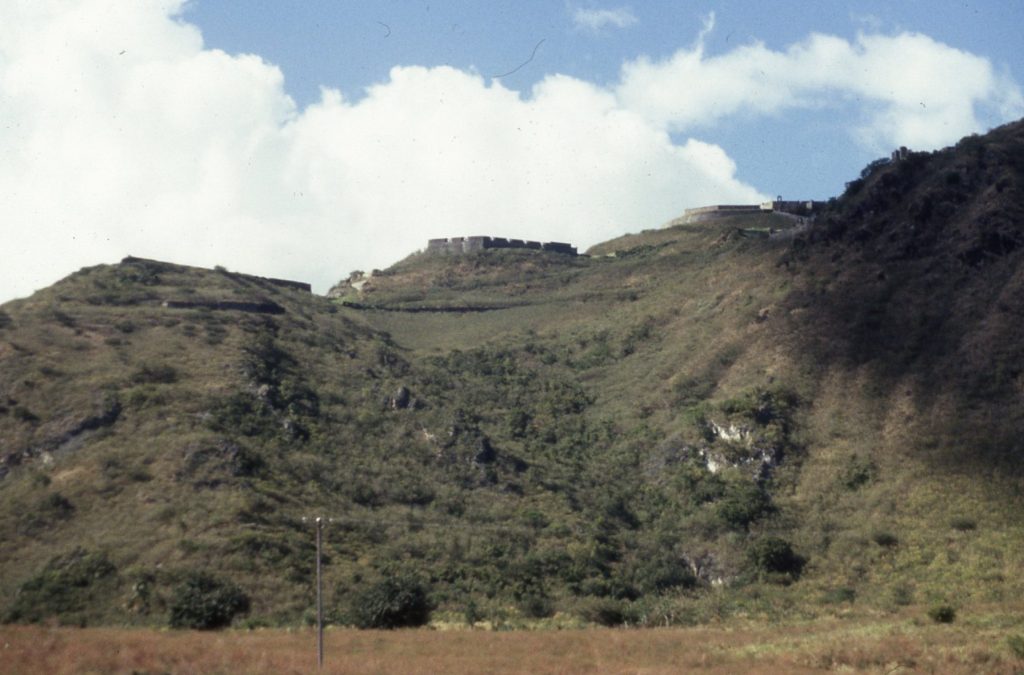Written by my husband, Steve:
All these years later I am still proud and humbled to have been the first manager of Brimstone Hill Fortress National Park on the Eastern Caribbean island of St. Kitts. It was November 1987, and I was a newly arrived U.S. Peace Corps Volunteer.
The previous year I had completed my graduate studies in Natural Resource Management with an emphasis in Parks and Wildlife, so this was an ideal assignment. I am also a history buff, so the time and effort I immediately put into learning the history of the island and the fortress was like one of the soft tropical breezes that greeted me as I stepped off the plane.
 St. Kitts (officially St. Christopher) was the first British colony in the West Indies, (this area of the globe is also known as the Eastern Caribbean, Leeward Islands, and the Lesser Antilles), established in 1624.
St. Kitts (officially St. Christopher) was the first British colony in the West Indies, (this area of the globe is also known as the Eastern Caribbean, Leeward Islands, and the Lesser Antilles), established in 1624.
 To their everlasting regret, these self-same colonists agreed to share the island with a group of imperiled French colonists in 1627. The first few years, this idyl seemed to be working, especially when banding together to wipe out the resident Carib Indians – which they did in 1630. They even went so far as to split the island amongst themselves – the British getting the middle and the French both ends. That explains why, even to this day, you’ll find towns like Basseterre at one end and Dieppe Bay at the other, and Middle Island and Sandy Point in the center.
To their everlasting regret, these self-same colonists agreed to share the island with a group of imperiled French colonists in 1627. The first few years, this idyl seemed to be working, especially when banding together to wipe out the resident Carib Indians – which they did in 1630. They even went so far as to split the island amongst themselves – the British getting the middle and the French both ends. That explains why, even to this day, you’ll find towns like Basseterre at one end and Dieppe Bay at the other, and Middle Island and Sandy Point in the center.

 As you can guess, this was not a recipe for long-lasting peaceful coexistence. You can say that colonial leaders eventually deferred to the goings on in Europe. That is, if England and France were at peace, St. Kitts was at peace. If England and France were at war, St. Kitts was at war too.
As you can guess, this was not a recipe for long-lasting peaceful coexistence. You can say that colonial leaders eventually deferred to the goings on in Europe. That is, if England and France were at peace, St. Kitts was at peace. If England and France were at war, St. Kitts was at war too.
The overriding reason for colonizing St. Kitts, and the West Indies, was economic exploitation. St. Kitts started with indigo and then tobacco before hitting on sugar cane – all based on slave labor. To protect these immensely profitable industries from pirates and Spanish or Dutch raiders, a series of forts were constructed along the shoreline at strategic locations all around the island. The main town/port in the British sector was Sandy Point Town. Protection was provided by Charles Fort located on the southeast edge of town.
 In 1690, the French and English were engaged in one of their recurring wars. The French attacked and captured Charles Fort and with it, control of the economic center of Sandy Point. The British set about planning its recapture. The only question was how? It was quite the conundrum. That is, until some bright soul cast his gaze inland.
In 1690, the French and English were engaged in one of their recurring wars. The French attacked and captured Charles Fort and with it, control of the economic center of Sandy Point. The British set about planning its recapture. The only question was how? It was quite the conundrum. That is, until some bright soul cast his gaze inland.
The entire island is dominated by a chain of volcanic mountains running along its spine from the northwest to the southeast. The tallest is located directly behind Sandy Point and is known as Liamuiga, Mount Misery to the British. Directly in line with the mountain and Charles Fort is an 800-foot-tall volcanic plug called Brimstone Hill. The smell of sulfur in the area was called brimstone by the 17th century inhabitants, hence the origin of the name.
 The British were quickly hacking a road up the back side of Brimstone Hill out of sight of the French occupiers of Charles Fort. Soon enough, cannonballs were raining down out of the tropical blue sky on the dumfounded French, and they promptly surrendered the fort back to the British.
The British were quickly hacking a road up the back side of Brimstone Hill out of sight of the French occupiers of Charles Fort. Soon enough, cannonballs were raining down out of the tropical blue sky on the dumfounded French, and they promptly surrendered the fort back to the British.
The British realized that if they just reoccupied Charles Fort and abandoned Brimstone, there would be no guarantee that the French wouldn’t one day return the favor. Thus, the decision was made to construct a permanent presence. And so, Brimstone Hill Fortress, the Gibraltar of the West Indies, was born.
 Over the following 164 years – the fortress was abandoned in 1854 – Brimstone Hill Fortress grew into one of the most imposing and impressive fortresses in the entire western hemisphere. It was designed by British military engineers but was constructed and maintained by slave labor. Slaveowners were compelled to provide a set percentage of their slaves (usually 10%) as construction workers. Those assigned were required to show up with all necessary tools and food-after all, the fortress was being constructed to protect the planting class.
Over the following 164 years – the fortress was abandoned in 1854 – Brimstone Hill Fortress grew into one of the most imposing and impressive fortresses in the entire western hemisphere. It was designed by British military engineers but was constructed and maintained by slave labor. Slaveowners were compelled to provide a set percentage of their slaves (usually 10%) as construction workers. Those assigned were required to show up with all necessary tools and food-after all, the fortress was being constructed to protect the planting class.
During that period of occupancy, and excepting the 1690 effort, the fortress only saw action once…and they lost! At the end of the American Revolutionary War, when the British surrendered at Yorktown in October 1781, the war relocated and continued in the Eastern Caribbean.
On January 11, 1782, the French landed 1200 men on St. Kitts and marched on Brimstone Hill where they lay siege on January 19th. The British had 700 defenders within the walls, including island militia and a company of naval gunners rushed to the Hill from the forces of the British Navy. (Being a Seattle native, I will note that one of those naval gunners was a 16-year-old midshipman by the name of Peter Puget. Nine years later, now a lieutenant, he was part of Captain George Vancouver’s expedition along the north Pacific coast where his actions eventually led to having Puget Sound named after him.)
The Siege of Brimstone Hill was a successful French strategy as the British garrison, granted full military honors – marching out with flags and guns – surrendered on February 13th. It seemed that the British hold on the Eastern Caribbean might finally be broken. But the vagaries and winds of war blow in many directions and additional battles and skirmishes throughout the region resulted in a strategic stalemate. Neither the French nor the British held the upper hand when the Treaty of Paris was negotiated and signed in 1783. Brimstone Hill and St. Kitts were returned to England after a single year under French control.







Thanks for the history lesson Steve – very interesting!